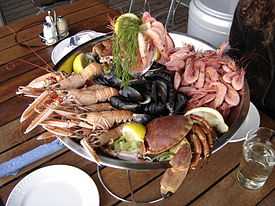Floribbean cuisine
| This article is part of the series |
| American cuisine |
|---|
|
Regional cuisines Northeastern
Other |
|
Ingredients
|
|
Styles
|
|
Ethnic and cultural
|
|
Holidays and festivals
|
|
|

Floribbean cuisine is found in varying forms in Florida restaurants and in the homes of many Floridians throughout the state. The essence of what makes a particular dish "Floribbean" is similar to many other aspects of Floridian culture: that it is heavily influenced by visitors and immigrants from all over the world, but especially from the Caribbean (with notable influence from Haiti, The Bahamas, Barbados, Jamaica, and Trinidad and Tobago). In the case of the Southern Florida region in particular, a subdivision called Latin-Floribbean or Hispano-Floribbean cuisine also takes Latin American cuisine traits from such countries as Cuba, Puerto Rico, Colombia, Argentina, Brazil, and the Dominican Republic, adding further influences into the mix. To distinguish the Latin Caribbean style from the non-Latin Caribbean style, some employ the terms Afro-Floribbean cuisine and Indo-Floribbean cuisine, as the majority of the Caribbean islands are of either African or Indian heritage, which in turn were colonized by British, French, and Dutch settlers.
Overview
The migration of Asian workers, to replace the freed African slaves, has also played an important role in Floribbean cuisine. Asian and Mediterranean inspired foods and cooking habits have made Floribbean cuisine more healthy in the foods used and the cooking of those foods. It has led to an even more exotic spice pantry. Red curry, lemongrass, ginger, scallions and all, have become as commonly used today in Floribbean cookery as grits and grunts are in other parts of Florida.
Typical features of Floribbean cuisine include:
- An emphasis on extremely fresh ingredients[1]
- Complex medleys of spices, especially powerful flavors that are softened by milder ones[1]
- An emphasis on seafood and poultry
- Generous use of fresh fruit and juices, especially citrus and sweet tropical fruits
- Special care in presentation, especially when seeking a more natural effect rather than an ostentatious one
Floribbean cooking often uses less heat than the Caribbean dishes that inspire it, but there is extensive use of several peppers. This spiciness, however, is almost always moderated by more gentle flavorings such as mango, papaya, rum, almond, coconut, key lime, or honey.[1]
It is common in homes to see traditional Deep Southern foods found in other states such as Texas, Georgia, Tennessee, and Louisiana (such as gumbo, coleslaw, black-eyed peas, or crab cakes) served in the same meal as a more nuanced Floribbean dish. In most Floribbean restaurants, however, entire meals are carefully planned around a succession of delicate, complex flavors and so most dishes have been altered from their traditional forms.
Fusions
Floribbean barbecue
Further information: Regional variations of barbecue
This is one of the three regional versions of barbecue in Florida, found mainly in Central Florida, of which this is the first of two styles to be influenced by Caribbean. This version of Floridian barbecue basically mixes American Deep South barbecue styles with Indo-Caribbean and Afro-Caribbean barbecue styles.
Latin-Floribbean cuisine
This mixes Floribbean cuisine with Latin American cuisine. It has strong Cuban, Puerto Rican, and Dominican influences.[2] Below are some examples:
- Arroz con Pollo
- White Rice and Black Beans
- Lechón
- Arroz con Gandules
- Tostones
- Boiled Yuca
- Paella
- Alcapurrias
Tropical barbacoa
A fusion of Floribbean barbecue and Latin-Floribbean cuisine, tropical barbacoa blends Cuban, Puerto Rican, Jamaican, Bahamian,and American Deep South barbecue cuisines. This is another of the three regional barbecue styles in Florida, found mainly in Southern Florida, and the second of two influenced by Caribbean cuisines. This is also the only Floridian barbecue style that is also influenced by Latin American cuisine. One example of this style would be pechuga de pollo a la plancha (grilled chicken breast seasoned with citrus juice). The rodizio is also very commonly utilized in this barbecue style.
Notes
- ↑ 1.0 1.1 1.2 Blum, Andrea A. (April 22, 2004). "Floribbean cuisine is the marriage of the familiar, and not-so-familiar" in The Saint Augustine Record.
- ↑ Nenes, Michael F. (2007) "American Regional Cuisine", Hoboken, NJ: John Wiley & Sons, Inc.
Bibliography
- Hartz, Deborah (2004). "What Goes Around..." South Florida Sun Sentinel. March 25.
- Lang, John (2007). "America, the Melting Pot." Foodservice Director. August 15.
- Parseghian, Pamela (2002). "Hunger for new tastes drives Caribbean menu influences." Nation's Restaurant News.
- Richman, Alan (2004). Fork it over: the Intrepid Adventures of a Professional Eater. New York: HarperCollins.
| ||||||||||||||